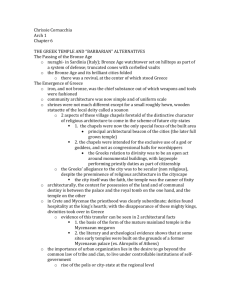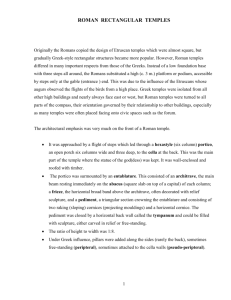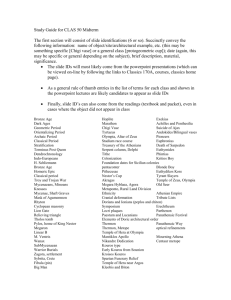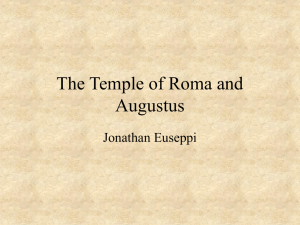Structure
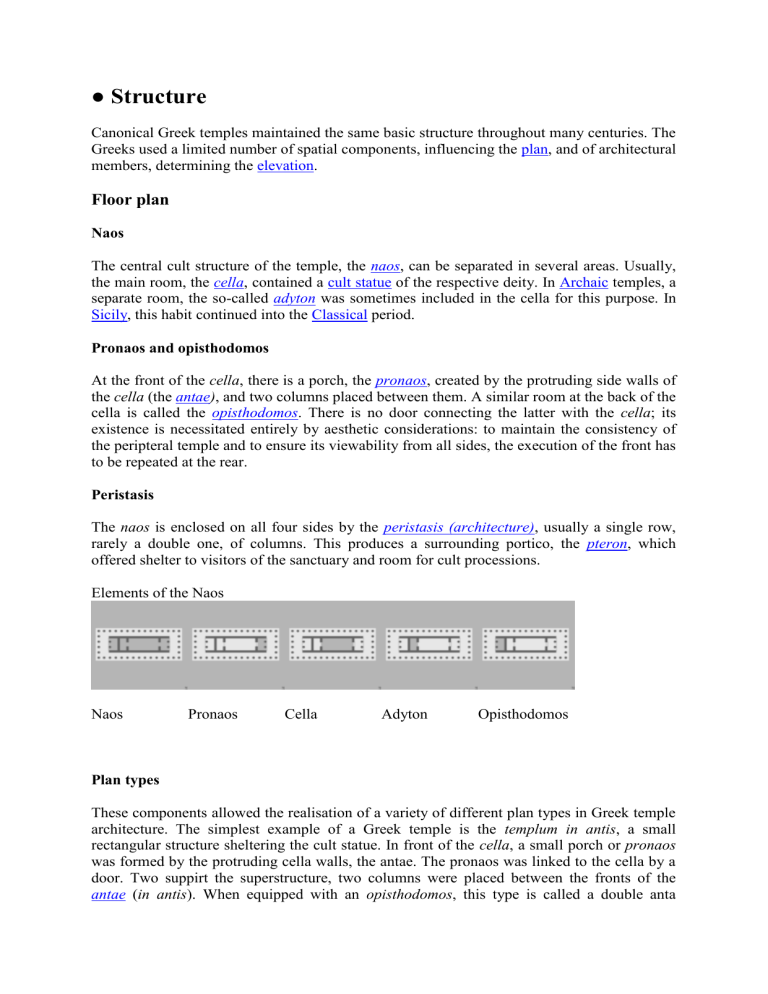
● Structure
Canonical Greek temples maintained the same basic structure throughout many centuries. The
Greeks used a limited number of spatial components, influencing the plan , and of architectural members, determining the elevation .
Floor plan
Naos
The central cult structure of the temple, the naos , can be separated in several areas. Usually, the main room, the cella , contained a cult statue of the respective deity. In Archaic temples, a separate room, the so-called adyton was sometimes included in the cella for this purpose. In
Sicily , this habit continued into the Classical period.
Pronaos and opisthodomos
At the front of the cella , there is a porch, the pronaos , created by the protruding side walls of the cella (the antae ) , and two columns placed between them. A similar room at the back of the cella is called the opisthodomos . There is no door connecting the latter with the cella ; its existence is necessitated entirely by aesthetic considerations: to maintain the consistency of the peripteral temple and to ensure its viewability from all sides, the execution of the front has to be repeated at the rear.
Peristasis
The naos is enclosed on all four sides by the peristasis (architecture) , usually a single row, rarely a double one, of columns. This produces a surrounding portico, the pteron , which offered shelter to visitors of the sanctuary and room for cult processions.
Elements of the Naos
Naos Pronaos Cella Adyton Opisthodomos
Plan types
These components allowed the realisation of a variety of different plan types in Greek temple architecture. The simplest example of a Greek temple is the templum in antis , a small rectangular structure sheltering the cult statue. In front of the cella , a small porch or pronaos was formed by the protruding cella walls, the antae. The pronaos was linked to the cella by a door. Two suppirt the superstructure, two columns were placed between the fronts of the antae ( in antis ). When equipped with an opisthodomos , this type is called a double anta
temple. A variant of that type has the opisthodomos at the back of the cella indicated merely by half-columns and shortened antae , so that it can be described as a pseudo-opisthodomos .
Different temple plans
If the porch of a temple in antis has a row of usually four or six columns in front of its whole breadth, the temple is described as a prostylos or prostyle temple . An amphiprostylos repeats the same column setting at the back.
In contrast, the term peripteros designates a temple surrounded by ptera (collonades) on all four sides, each usually formed by single row of columns. This produces an unobstructed surrounding portico, the peristasis , on all four sides of the temple. A Hellenistic and Roman form of this shape is the pseudoperipteros , where the side and rear porches are indicated only by engaged columns or pilasters directly attached to the external cella walls.
A dipteros is equipped with a double collonade on all four sides, sometimes with further rows of columns at the front and back. A pseudodipteros lacks the inner row of columns in its peristasis , but has porches of double width.
Circular temples form a special type. If they are surrounded by a collonade, they are known as peripteral tholoi . Although of sacred character, their function as a temple can often not be asserted. A comparable structure is the monopteros , or cyclostyle which, however, lacks a cella .
To clarify ground plan types, the defining terms can be combined, producing terms such as: peripteral double anta temple, prostyle in antis , peripteral amphiprostyle, etc.
Column number terminology
An additional definition, already used by Vitruvius (IV, 3, 3) is determined by the number of columns at the front. Modern scholarship uses the following terms:
technical term number of columns at front distyle 2 columns tetrastyle hexastyle octastyle
4 columns, term used by Vitruvius
6 columns, term used by Vitruvius
8 columns decastyle 10 columns
The term dodekastylos is only used for the 12-column hall at the Didymaion . No temples with facades of that width are known.
Very few temples had an uneven number of columns at the front. Examples are Temple of
Hera I at Paestum , Temple of Apollo A at Metapontum , both of which have a width of nine columns (enneastyle), and the Archaic temple at Thermos with a width of five columns
(pentastyle).
Elevation
Elevation of the Temple of Concordia at Agrigentum .
The elevation of Greek temples is always subdivided in three zones: the crepidoma , the columns and the entablature .
Foundations and crepidoma
The underground foundation of a Greek temple is known as the stereobate . It consists of several layers of squared stone blocks. The uppermost layer, the euthynteria , partially protrudes above the ground level. Its surface is carefully smoothed and levelled. It supports a further foundation of three steps, the crepidoma . The uppermost level of the crepidoma provides the surface on which the columns and walls are placed; it is called stylobate .
Stereobate, euthynteria and crepidoma form the substructure of the temple.
Illustration of Doric (first three), Ionic (next three) and Corinthian (final two) columns.
Columns
Placed on the stylobate are the vertical column shafts, tapering towards the top. They are normally made of several separately cut column drums. Depending on the architectural order, a different number of flutings are cut into the column shaft: Doric columns have 18 to 20 flutings, Ionic and Corinthian ones normally have 24. Early Ionic columns had up to 48 flutings. While Doric columns stand directly on the stylobate, Ionic and Corinthian ones possess a base, sometimes additonally placed atop a plinth .
In Doric columns , the top is formed by a concavely curved neck, the hypotrachelion , and the capital , in Ionic columns, the capital sits directly on the shaft. In the Doric order, the capital consists of a circular torus bulge, originally very flat, the so-called echinus , and a square slab, the abacus . In the course of their development, the echinus expands more and more, culminating in a linear diagonal, at 45° to the vertical. The echinus of Ionic columns is decorated with an egg-and-dart band followed by a sculpted pillow forming two volutes , supporting a thin abacus . The eponymous Corinthian capital of the Corinthian order is crowned by rings of stylised acanthus leaves, forming tendrils and volutes that reach to the corners of the abacus .
Entablature on the west side of the Parthenon .
Entablature
The capitals support the entablature . In the Doric order, the entablature always consists of two parts, the architrave and the Doric frieze (or triglyph frieze). The Ionic order of Athens and the Cyclades also used a frieze above an architrave, whereas the frieze remained unknown in the Ionic architecture of Asia Minor until the 4th century BC. There, the architrave was directly followed by the dentil . The frieze was originally placed in front of the roof beams,
which were externally visible only in the earlier temples of Asia Minor. The Doric frieze was structured by triglyphs . These were placed above the axis of each column, and above the centre of each intercolumniation . The spaces between the triglyphs contained metopes , sometimes painted or decorated with relief sculpture. In the Ionic or Corinthian orders, the frieze posseses no triglyphs and is simply left flat, sometimes decorated with paintings or reliefs. With the introduction of stone architecture, the protection of the porticos and the support of the roof construction was moved upwards to the level of the geison , depriving the frieze of its structural function and turning it into an entirely decorative feature. Frequently, the cella is also decorated with architrave and frieze, especially at the front of the pronaos .
Geison block from the temple at Lykosoura .
Cornice and geison
Above the frieze, or an intermediate member, eg. the dentil of the Ionic or Corinthian orders, the cornice protudes notably. It consists of the geison (on the sloped sides or pediments of the narrow walls a sloped geison ), and the sima . On the long side, the sima , often elaborately decorated, was equipped with water spouts, often in the shape of lions' heads. The pedimental triangle or tympanon on the narrow sides of the temple was created by the Doric introduction of the gabled roof , earlier temples often had hipped roofs . The tympanon was usually richly decorated with sculptures of mythical scenes or battles. The corners and ridges of the roof were decorated with acroteria , originally geometric, later floral or figural decorations.
Aspect
As far as topographically possible, the temples were freestanding and designed to be viewed from all sides. They were not normally designed with consideration for their surroundings, but formed autonomous structures. This is a major difference from Roman temples which were often designed as part of a planned urban area or square and had a strong emphasis on being viewed frontally.
● Design and measurements
By using carefully calculated mathematical proportions, Greek architects made massive structures like the Parthenon appear harmonious.
Proportions
The foundations of Greek temples could reach dimensions of up to 115 by 55 m, i.e. the size of an average soccer field. Columns could reach a height of 20 m. To design such large architectural bodies harmoniously, a number of basic aesthetic principles were developed and tested already on the smaller temples. the main measurement was the foot , varying between
29 and 34 cm from region to region. This initial measurement was the basis for all the units that determined the shape of the temple. Important factors include the lower diameter of the columns and the width od their plinths. The distance between the column axes
( intercolumniation or bay ) could also be used as a basic unit. these meausrements were in set proportions to other elements of design, such as column height and column distance. In conjunction with the number of columns per side, they also determined the dimensions of stylobate and peristasis , as well as of the naos proper. The rules regarding vertical proportions, especially in the Doric order, also allow for a deduction of the basic design options for the entablature from the same principles. Alternatives to this very rational system were sought in the temples of the late 7th and early 6th centuries BC, when it was attempted to develop the basic measurements from the planned dimensions of cella or stylobate, i.e. to reverse the system described above and deduce the smaller units from the bigger ones. Thus, for example, the cella length was sometimes set at 100 foot (100 is a sacred number, also known from the hecatomb , a sacrifice of 100 animals), and all further measurements had to be in relation to this number, leading to aesthetically quite unsatisfactory solutions.
Naos-peristasis relationship
Another determining design feature was the relationship linking naos and peristasis . In the original temples, this would have been subject entirely to practical necessities, and always based on axial links between cella walls and columns, but the introduction of stone architecture broke that connection. Nevertheless, it did survive throughout Ionic architecture.
In Doric temples, however, the wooden roof construction, originally placed behind the frieze, now started at a higher level, behind the geison . This ended the structural link between frieze and roof; the structural elements of the latter could now be placed independent of axial relationships. As a result, the cella walls lost their fixed connection with the columns for a long time and could be freely placed within the peristasis . Only after a long phase of developments did the architects choose the alignment of the outer wall face with the adjacent
column axis as the obligatory principle for Doric temples. Doric temples in Greater Greece rarely follow this system.
Column number formula
The basic proportions of the building were determined by the numeric relationship of columns on the front and back to those on the sides. The classic solution chosen by Greek architects is the formula "frontal columns : side columns = n : (2n+1)", which can also be used for the number of intercolumniations. As a result, numerous temples of the Classical period in Greece
( circa 500 to 336 BC) had 6 x 13 columns or 5 x 11 intercolumnitions. The same proportions, in a more abstract form, determine most of the Parthenon , not only in its 8 x 17 column peristasis , but also, reduced to 4:9, in all other basic measurements, including the intercolumniations, the stylobate, the width-height proportion of the entire building, and the geison (here reversed to 9:4).
[18]
Proportion of column diameter to intercolumnium.
Column spacing
Since the turn of the 3rd and 2nd centuries BC, the proportion of column width to the space between columns, the intercolumnium, played an increasingly important role in architectural theory, reflected, for example, in the works of Vitruvius . According to this proportion,
Vitruvius (3, 3, 1 ff) distinguished between five different design concepts and temple types:
Pyknostyle, tight-columned: intercolumnium = 1 ½ lower column diameters
Systyle, close-columned: intercolumnium = 2 lower column diameters
Eustyle, well-columned: intercolumnium = 2 ¼ lower column diameters
Diastyle, board-columned: interkolumnium = 3 lower column diameters
Araeostyle, light-columned: intercolumnium = 3 ½ lower column diameters
The determination and discussion of these basic principles went back to Hermogenes , whom
Vitruvius credits with the invention of the eustylos . The Temple of Dionysos at Teos , normally ascribed to Hermogenes, does indeed have intercolumnia measuring 2 ⅙ of the lower column diameters.
● Optical refinements
Exaggerated sketch of the curvature of a Doric temple.
To loosen up the mathematical strictness and to counteract distortions of human visual pereception, a slight curvature of the whole building, hardly visible with the naked eye, was introduced. The ancient architects had realised that long horizontal lines tend to make the optical impressio of sagging towards their centre. To prevent this effect, the horizontal lines of stylobate and/or entablature were raised by a few centimetres towards the middle of a building. This avoidance of mathematically straight lines also included the columns, which did not taper in a linear fashion, but were refined by a pronounced "swelling" ( entasis ) of the shaft. Additionally, columns were placed with a slight inclination towards the centre of the building. Curvature and entasis occur from the mid 6th century BC onwards. The most consistent use of these principles is seen in the Classical Parthenon on the Athenian
Acropolis . Its curvature affects all horizontal elements up to the sima, even the cella walls reflect at throughout their height. The inclination of its columns (which also have a clear entasis), is continued by architrave and triglyph frieze, the external walls of the cella also reflect it. Not one block of the building, not a single architrave or frieze element could be hewn as a simple rectilinear block. All architectural elements display slight variations from the right angle, individually calculated for each block. As a side effect, each preserved building block from the Parthenon, its columns, cella walls or entablature, can be assigned its exact position today. In spite of the immense extra effort entailed in this perfection, the
Parthenon, including its sculptural decoration, was completed in the record time of sixteen years (447 to 431 BC).
● Decoration
Reconstruction of original painted state on a scaffolding covering the Temple of Concordia ,
Akragas .
Colouring
Greek temples were, as a rule, colourfully painted. Only three basic colours, with no shades, were used: white, blue and red, occasionally also black. The crepidoma, columns and architrave were mostly white. Only details, like the horizontally cut grooves at the bottom of
Doric capitals ( anuli ), or decorative elements of Doric architraves (eg. taenia and guttae ) might be painted in different colours. The frieze was clearly structured by use of colours. In a
Doric triglyph frieze, blue triglyphs alternated with red metopes, the latter often serving as a background for individually painted sculptures. Reliefs, ornaments and pedimental sculptures were exceuted with a wider variety of colours and nuances. Recessed ot otherwise shaded elements, like mutules or triglyph slits could be painted black. Paint was mostly applied to parts that were not load-bearing, whereas structural parts like columns or the horizontal elements of architrave and geison were left unpainted (if made of high quality limestone or marble) or covered with a white stucco .
Architectural sculpture
A centaur struggling with a Lapith - Metope from the Parthenon .
Greek temples were often enhanced with figural decorations. especially the frieze areas offered space for reliefs and relief slabs; the pedimental triangles often contained scenes of free-standing sculpture . In Archaic times, even the architrave could be relief-decorated on
Ionic temples, as demonstrated by the earlier temple of Apollo at Didyma . Here, the
architrave corners bore gorgons , surrounded by lions and perhaps other animals. On the other hand, the Ionic temples of Asia Minor did not possess a separate frieze to allow space for relief decoration. The most common area for relief decoration remained the frieze, either as a typical Doric triglyph frieze, with sculpted metopes, or as a continuous frieze on Cycladic and later on Eastern Ionic temples.
Metopes
The metopes , separate individual tableaux that could usually not contain more than three figures each, usually depicted individual scenes belonging to a broader context. It is rare for scenes to be distributed over several metopes; instead, a general narrative context, usually a battle, is created by the combination of multiple isolated scenes. Other thematical contexts could be depicted in this fashion. Foe example, the metopes at the front and back of the
Temple of Zeus at Olympia depicted the Twelve Labours of Heracles . Individual mythological scenes, like the abduction of Europa or a cattle raid by the Dioscuri could be thus depicted, as could scenes from the voyage of the Argonauts or the Trojan War . The battles against the centaurs and amazons , as well as the gigantomachy , all three depcited on the Parthenon , were recurring themes on many temples.
Part of the Parthenon Frieze , in situ on the west side of the naos .
Friezes
Battle scenes of all kinds were also a common theme of Ionic friezes, eg. the Gigantomachy on the temple of Hekate at Lagina , or the Amazonomachy on the temple of Artemis at
Magnesia on the Maeander , both from the late 2nd century BC. Complex compositions visualised the back and forth of fighting for the viewer. Such scenes were contrasted by more quiet or peaceful ones: The Assembly of the gods and a procession dominate the 160 m long frieze that is placed on top of the naos walls of the Parthenon .
Reconstruction of the west pediment on the Parthenon , Athens , Acropolis Museum .
Pediments
Special attention was payed to the decoration of the pedimental triangles, not least because of their size and frontal position. Originally, the pediments were filled with massive reliefs, eg.
shortly after 600 BC on the temple of Artemis at Kerkyra , where the west pediment is taken up by the gorgon Medusa and her children at the centre, flanked by panthers. Smaller scenes are displayed in the low corners of the pediments, eg. Zeus with a thunderbolt, fighting a
Giant . The pedimental sculpture of the first peripteral temple on the Athenian Acropolis , from circa 570 BC, is nearly free-stading sculpture, but remains dominated by a central scene of fighting lions.
Statue of Apollo from the west pediment of the Temple of Zeus at Olympia .
Again, the corners contain separate scenes, including Heracles figting Triton . After the mid-
6th century BC, the compositional scheme changes: animal scens are now placed in the corners, soon they disappear entirely. The central composition is now taken over by mythological fights or by rows of human figures. The high regard in which the Greeks held pedimental sculptures in demonstrated by the discovery of the sculptures from the Late
Archaic temple of Apollo at Delphi , which had received a vertiable burial after the temple's destruction in 373 BC.
[21]
The themes of the individual pedimental scens are increasingly dominated by myths connected with the locality. Thus, the east pediment at Olympia depicts the preparations for a chariot race between Pelops and Oinomaos , the mythical king of nearby
Pisa . It is the foundation myth of the sanctuary itself, displayed here in its most prominent position. A similarly direct association is provided by the birth of Athena on the east pediment of the Parthenon , or the struggle for Attica between her and Poseidon on its west pediment.
The pediment of the later temple of the Kabeiroi at Samothrace , late 3rd century BC, depicted a probably purely local legend, of no major interest to Greece as a whole.
Mounted nereid ; corner acroterion from the temple of Asklepios at Epidauros .
Roofs
The roofs were crowned by acroteria , originally in the form of elaborately painted clay disks, from the 6th century BC onwards as fully sculpted figures placed on the corners and ridges of
the pediments. They could depict bowls and tripods , griffins , spinxes , and especially mythical figures and deities. For example, depictions of the running Nike crowned the Alcmaeonid temple of Apollo at Delphi, and mounted amazons formed the corner akroteria of the temple of Asklepios in Epidauros . Pausanias (5, 10, 8) describes bronze tripods forming the corner akroteria and statues of Nike by Paeonios forming the ridge ones on the Temple of Zeus at
Olympia .
Columns
For the sake of completeness, a further potential bearer of sculptural decoration should be mentioned here: the columnae celetae of the Ionic temples at Ephesos and Didyma . Here, already on the Archaic temples, the lower parts of the column shafts were decorated by protruding relief decorations, originally depicting rows of figures, replaced on their late
Classical and Hellenistic successors with mythological scenes and battles.
[22]
● Function and design
Reconstruction of the chryselephantine statue of Athena Parthenos , from the Parthenon , on display at the Nashville Parthenon .
Cult statue and cella
The functions of the temple mainly concentrated on the cella , the "dwelling" of the cult statue.
The elaboration of the temple's external aspects served to stress the dignity of the cella . In contrast, the cella itself was often finished with some moderation. The only source of light for cella and cult statue was the cella' s frontal door. Thus, the interior only received a limited amount of light. Exceptions are found in the temples of Apollo at Bassae and of Athena at
Tegea , where the southern cella wall had a door, potentially allowing more light into the interior. A special situation applies to the temples of the Cyclades , where the roof was usually of marble tiles. Marble roofs also covered the temple of Zeus at Olympia and the Parthenon at
Athens . As marble is not entirely opaque, those cellas may have been permeated with a distinctive diffused light. For cultic reasons, but also to use the light of the rising sun, virtually all Greek temples were oriented to the east. Some exceptions existed, eg. the west-
facing temples of Artemis at Ephesos and at Magnesia on the Maeander , or the north-south oriented temples of Arcadia . Such exceptions are probably connected with cult practice.
Temple of Aphaia ( Aegina ): The interior of the cella was embellished with two tiers of Doric columns.
Refinements
The cult statue was often oriented towards an altar , placed axially in front of the temple. To preserve this connection, the single row of columns often found along the central axis of the cella in early temples was replaced by two separate rows towards the sides. The central one of the three aisles thereby created was often emphasised as the main one. The dignity of the central aisle of the cella could be underlined by the use of special elements of design. For example, the oldest known Corinthian capitals are from the naoi of Doric temples. The impressiveness of the internal aisle could be emphasised further by having a third row of columns along the back, as is the case at the Parthenon and at the temple of Zeus in Nemea .
The Parthenon cella', also had another impressive feature, namely two tiers of columns atop each other, as did the temple of Aphaia on Aegina . The temple of Athena at Tegea shows another variation, where the two column rows are indicated by half-columns protruding from the side walls and crowned with Corinthian capitals. An early form of this solution can be seen at Bassae, where the central column of the back portico remains free-stading, while the columns along the sides are in fact semi-columns connected with the walls by curved protrusions.
Plan and interior reconstruction of the Temple of Apollo Epikourios at Bassae . Note the side entrance to the cella and the single Corinthian column.
Restricted access
The cella of a Greek temple was entered only rarely and by very few visitors. Generally, entry to the room, except during important festivals or other special occasions, was limited to the priests. Sometimes, the divine character of the cult image was stressed even more by removing it further into a separate space within the cella , the adyton . Especially in Magna
Graecia , this tradition continued for a long time. Over the decades and centuries, numerous
votive offerings could be placed in the cella , giving it a museum-like character (Pausanias 5,
17).
Opisthodomos
The back room of the temple, the opisthodomos , usually served as a storage space for cult equipment. It could also hold the temple treasury. For some time, the opisthodomus of the
Athenian Parthenon contained the treausry of the Delian League , thus directly protected by the deity. Pronaos and opisthodomos were often closed off from the peristasis by wooden barriers or fences.
Peristasis
Like the cella, the peristasis could serve the display and storage of votives, often placed bwteen the columns. In some cases, votive offerings could also be directly affixed to the columns, as is visible eg. on the Temple of Hera at Olympia . The peristasis could also be used for cult processions , or simply as shelter from the elements, a function emphasised by
Vitruvius (III 3, 8f).
☻ Tekst pärineb internetilehelt http://en.wikipedia.org/wiki/Greek_Temple
